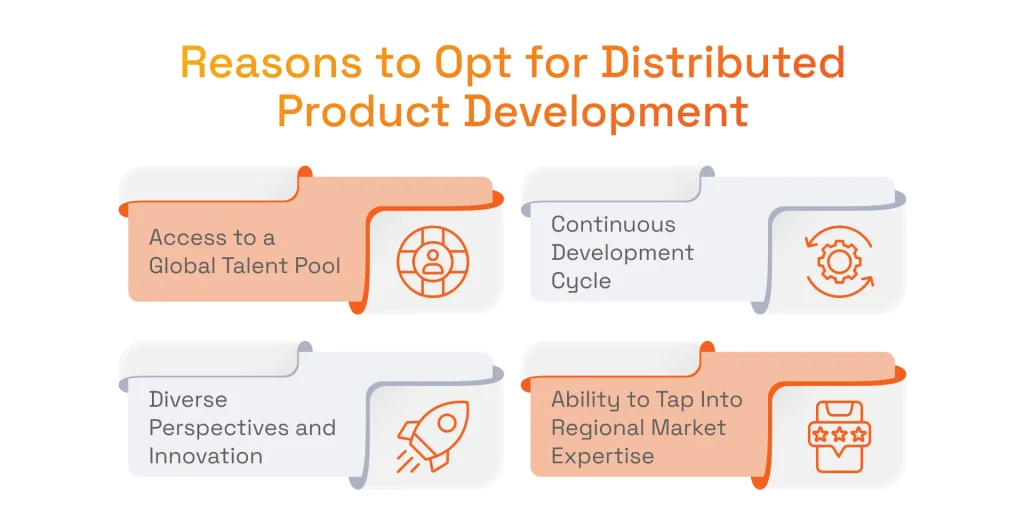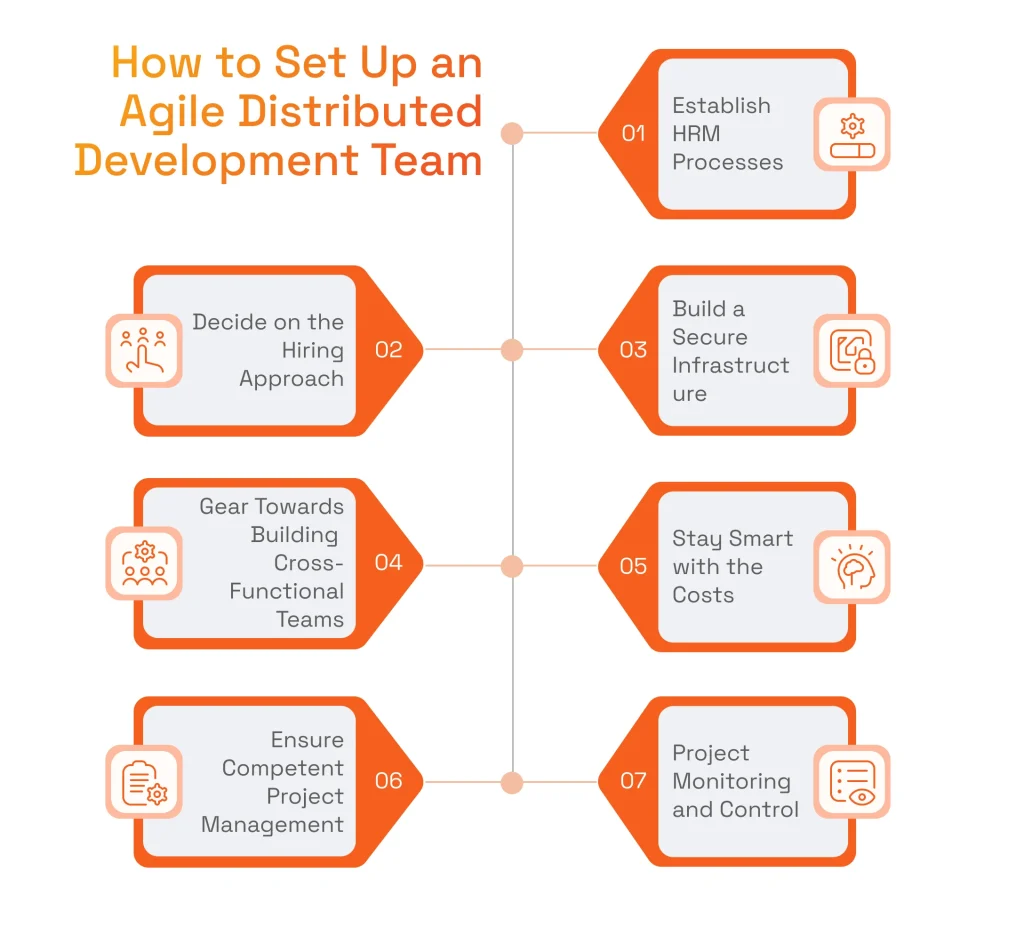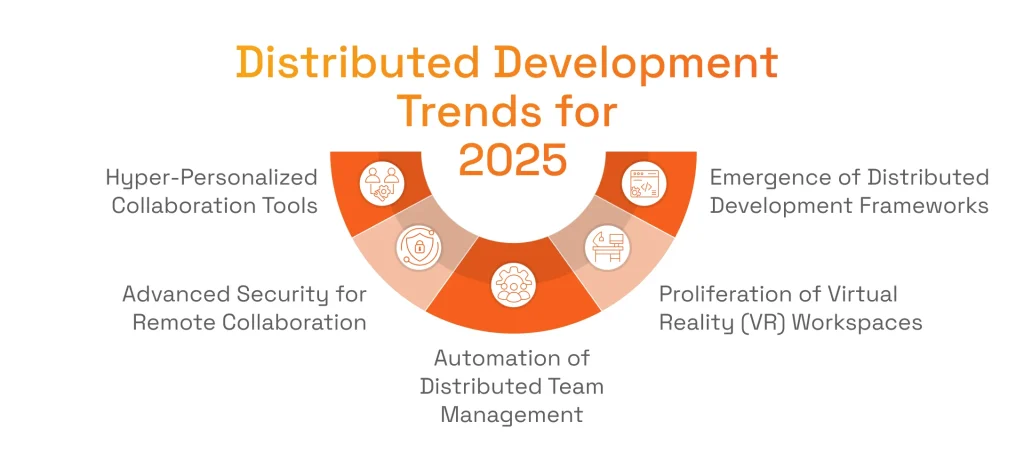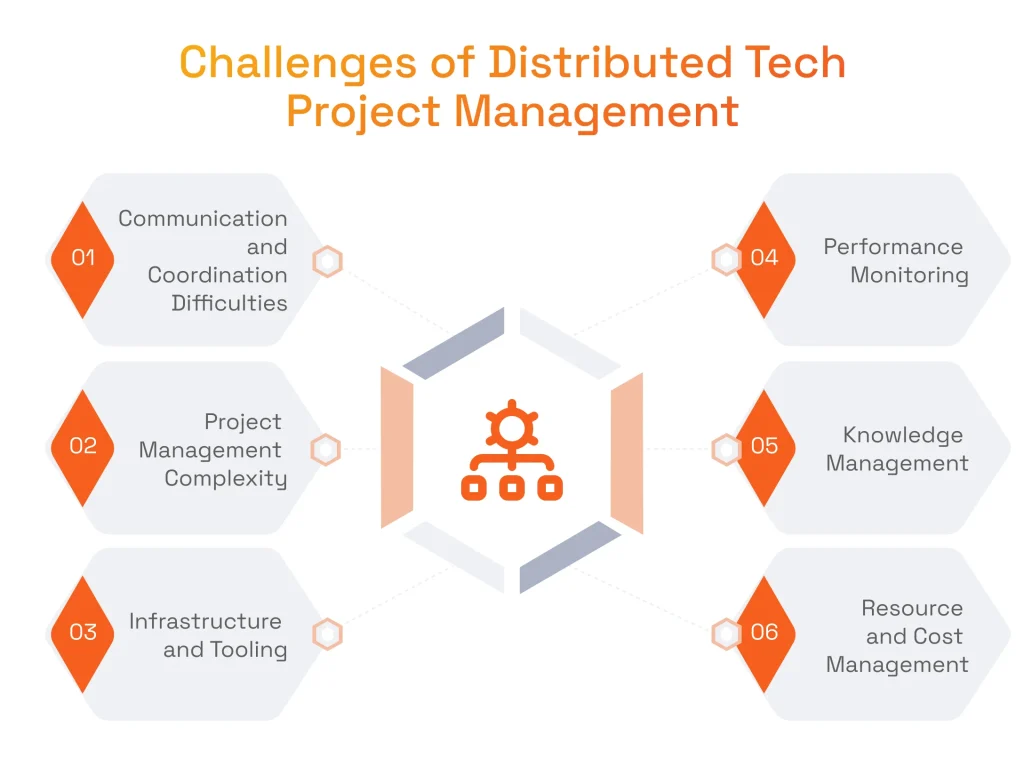The COVID-19 pandemic has been a game-changer for industries worldwide. Organizations have uncovered multiple benefits of remote work, one being the ability to hire tech talent from across the globe according to the outsourcing model.
Outsourcing IT specialists is done for various reasons. According to a report by Deloitte, 59% of companies outsource to reduce costs, and 57% do so to concentrate on their core business functions. However, such staffing can take many forms. One of the popular engagement models in development outsourcing is distributed software development, which allows for assembling a development team of top specialists, even if they are spread across multiple geographical locations. So, what are the benefits and challenges of this outsourcing practice? How do you set up a distributed team? Below we cover all these questions.
Why Choose Distributed Software Development Team Model?
Forming distributed software development teams allows for reaching a whole new level of productivity during the project life cycle. The distributed nature of this staffing model entails that most employees will likely work remotely. Before the COVID pandemic, leadership had been cautious about remote work, claiming it might decrease staff performance due to the lack of supervision and office discipline. However, after the COVID-19, the Statista report revealed that a majority of employees said that their company’s leadership trusted remote workers to be productive, with 54% believing all employees were trustworthy.
While leadership is happy with the remote work results, employees are also not in a rush to return to the office. Globally, the percentage of remote workers increased drastically, rising from 20% in 2020 to 28% by 2023. The IT industry is, of course, the most prominent example, with 67% of its employees mainly working from home. The workforce is willing to work remotely due to flexible availability hours and the ability to work from any place.

Oleksandr Boiko
Delivery Director at SPD Technology
“While working according to a distributed development model, we not only get the flexibility in terms of our working schedules but also gain access to the most diverse software engineering experiences and specific skill sets. This creates a truly unique collaborative atmosphere where anyone can share their knowledge and level up their expertise.”
Value-Adding Reasons to Opt for Distributed Product Development
Working with distributed development teams entails several advantages that are inaccessible to projects developed by a team within a single location. Since our developers work on some projects from dispersed locations, we can tell that the benefits we mention below are backed by our experience.

Access to a Global Talent Pool
Assembling distributed teams does not limit companies in terms of geographic locations, allowing for finding and hiring highly skilled specialists from around the world. Thus, the recruitment process becomes faster as the hiring companies are not constrained by local skill shortages. Employers can locate the ideal candidates for their needs without having to spend a lot of time searching because more applicants can be sourced from different places.
At the same time, this global reach also helps optimize costs through access to broader labor markets. Hiring talent from countries with lower living costs can significantly reduce overall labor expenses without compromising quality. This maximizes the company’s financial efficiency and allows for better allocation of resources towards other essential areas.
Continuous Development Cycle
When distributed development team members work from different geographical locations, they do not work strictly from 9 to 5 as we know it. This is why project development can have an around-the-clock nature, which can be beneficial in times of tight deadlines. What’s more, this continuous project delivery is beneficial in cases when critical issues require immediate action or security breaches take place and need an urgent backup from a security team.
The utilization of cloud-based collaboration technologies further contributes to continuous project development. It guarantees that team members may remain connected no matter where they are and all the project assets are preserved and accessible at any time.
Diverse Perspectives and Innovation
Such a global reach makes it possible to find skilled developers to equip projects with unique expertise as well as tap into a more diverse range of experiences and perspectives typical for specific regions. For instance, Eastern and Western Europe have a large pool of technical talent that are well-versed in such innovative technologies as AI/ML engineering, data science, and DevOps. Southeast Asia, in turn, is well-known for blockchain development, and North America offers an impeccable cloud technology expertise.
In addition to hard skills, the soft skills and cultural backgrounds prevalent in different regions can provide advantages for various projects. In fact, McKinsey states that companies with the highest levels of ethnic and cultural diversity achieved a 36% profitability advantage over those with the lowest. For instance, Eastern European specialists often bring a strong focus on long working hours to meet tight deadlines. Latin American teams excel in relationship-oriented collaboration, fostering better rapport and adaptability. Meanwhile, professionals from the Asia-Pacific region tend to emphasize cohesive teamwork, providing a highly productive and supportive environment for your projects.
Ability to Tap Into Regional Market Expertise
Building geographically distributed teams places organizations closer to regional markets, which brings valuable local insights related to industry standards, consumer preferences, and regulatory frameworks. Collaborating with professionals who understand the nuances of local regulations and cultural contexts allows for tailoring business products or services to meet specific legal requirements and market demands more efficiently.
Plus, having teams embedded within different regions enhances the ability to localize offerings culturally and compliance–wise. This means much easier processes of adapting language, cultural references, user interfaces, payment methods, data protection policies, and marketing strategies to serve local audiences.
Wondering how to hire a dedicated development team for your project?
Read our guide and find out the necessary considerations!
How to Set Up an Agile Distributed Software Development Team: Best Practices
We’ve already shared 6 tips to help CTOs in outsourcing product development. However, we also decided to specify tactics for an effective collaboration when it comes to a distributed development team.

Decide on the Hiring Approach
At the beginning, employers need to choose how they would like to hire developers. There are three common ways to do it: direct hiring, virtual office, or an offshore development center (ODC).
In the first case, businesses can recruit team members themselves, which gives the privilege of ensuring they meet the project’s specific requirements. In the second case, a virtual office allows creating a centralized remote workspace with a good expertise involved in the project, while saving resources required for a physical location. In the third case, ODC can help tap into local talent pools and reduce operational costs.
Feel like setting up an offshore development center makes most sense for your business?
Our article will help you strategically build a value-driving ODC!
Gear Towards Building Cross-Functional Teams
To create a goal-oriented attitude within a team, it is essential to switch from building a functional team to assembling a cross-functional distributed team. The latter involves creating different roles, including front-end and back-end developers, a project manager, team lead, designers, and quality assurance experts. This makes it possible to equip the project with a spectrum of skills and expertise.
Furthermore, encouraging open communication among team members is crucial since it promotes problem-solving. In order to empower individuals within a distributed development team, increase their engagement, boost overall accountability, as well as promote team ownership and independent decision-making.
Ensure Competent Project Management
We have already mentioned that the best option for a distributed development team management is Agile. This means that the project requires project managers being assigned to each team. With managers, it becomes possible to establish correct Scrum processes and maintain control over the project with regular meet-ups, task supervision, and KPI tracking.
In case employers want to choose a more specific Agile approach, like Scrum, it won’t do any harm if the role of Scrum master will be taken by a project manager or a team lead. The main point is to delegate management tasks to the person who is responsible and skillful enough to organize the development process.
Establish HRM Processes
One of the most common pieces of advice for managing any team, including a distributed one, is to establish clear HR processes for each geographical region.
It will considerably improve the team relationships and culture when there is a person assigned to solve any issues between members of the team. Plus, an HR should be familiar with local employment laws, cultural norms, and regional challenges to help resolve any problems and help an employee focus on the project.
Build a Secure Infrastructure
Businesses need to make sure they use various layers of permissions to protect your projects by limiting access to critical information to only authorized workers. In order to defend against cyber attacks, make sure that the members of a distributed team have access to the newest security tools and technology. In addition, it is important to make sure the staff uses VPNs and pre-installed software on their devices to safeguard remote connections and ensure adherence to security guidelines.
Finally, but just as importantly, it is vital to remember to sign Non-Disclosure Agreements (NDAs) in order to preserve confidentiality and safeguard sensitive information. These precautions aid in preventing data breaches and protecting the intellectual property of the business.
Stay Smart with Current and Upcoming Costs
To ensure that a distributed software development team work stays uninterrupted by a sudden fiscal gap, you need to analyze rates and the economic environment in the target region. Thus, businesses can allocate optimal financial resources to salaries.
Also, it is recommended to invest in reliable communication tools, project management software, and secure network infrastructure. In such a way, businesses guarantee that their company’s infrastructure is ready for remote collaboration. In the case of opting for ODC, additional items of expenditure are office rent and expenses for utilities, maintenance, and local taxes.
Project Monitoring and Control
For ensuring that all the deliverables will be met in a timely and correct manner, businesses can use various best office suites and bug trackers. Tools like Okta and Google Workspace can make reporting and communication within a distributed team simple, while also providing real-time updates. On top of that, such systems help track progress, manage tasks, and identify issues that arise.

Oleksandr Boiko
Delivery Director at SPD Technology
“Assigning core roles is crucial. Specific individuals should be designated as the Chief Technical Officer, System Architect, and Director of Product Management. This ensures that employees have clear points of contact for expertise and support when project bottlenecks arise.”
Distributed Software Development Trends to Consider in 2025
Distributed work is arranged differently, and it is only natural that it has its unique characteristics. In 2025, many trends are changing how software is developed by geographically dispersed teams. The following trends illustrate these transformations and highlight the evolving environment of distributed software development.

Hyper-Personalized Collaboration Tools
AI-powered collaboration platforms are gaining more popularity, as they offer capabilities to adapt to time zones, team preferences, and task management patterns. These tools can learn from user behavior and further provide assistance in the task switching, messaging, and management during peak productivity hours. In particular, these tools can recommend optimal meeting times, task priorities, and even personalized “focus” or “do not disturb” windows.
Thanks to the integration of these platforms with task management systems, chat applications, and email clients, businesses can:
- Minimize distractions by reducing interruptions during work periods;
- Align tasks with peak efficiency periods by automatically scheduling tasks;
- Boost overall productivity by increasing the efficiency of work processes.
Rise of Decentralized Development Platforms
Traditional version control systems typically rely on centralized repositories where everyone contributes, yet it is not always possible to ensure transparent accountability. This created the demand for blockchain-based platforms as they store code contributions and commit histories in a distributed ledger. In these systems, access, permissions, and project governance are enforced through smart contracts, which ensure that every update is transparently recorded and verifiable.
Using blockchain-based platforms for development help businesses to:
- Improve security and promote fairness in collaborative coding environments;
- Protect intellectual property and ensure that code attribution is more straightforward;
- Support the adoption of tamper-proof records and strong audit trails.
Advanced Security for Remote Collaboration
With remote work continuing to expand, zero-trust architectures, where every request for data or system access must be verified and validated, are becoming standard. Biometric authentication, such as fingerprint and facial recognition, as well as real-time threat detection powered by AI are increasingly integrated into daily workflows. These solutions help monitor user activities, network traffic, and file access in real-time, flagging suspicious behavior before breaches can occur.
Thanks to the utilization of advanced security measures, businesses can be sure that the projects have:
- Lower the risk of data leaks, identity theft, and unauthorized access;
- Adherence to compliance requirements in such industries as healthcare, finance, and government.
Automation of Distributed Team Management
Many project managers involved in projects with multiple time zones, task dependencies, and communication channels quickly become overwhelmed with too many details they need to have in mind. Luckily, new AI-driven tools can automate tasks, especially when those tasks concern scheduling standups, assigning work based on skills and availability, and monitoring progress.
With AI-powered task managers, distributed development projects can benefit from:
- Enhanced focus as project managers and product owners get the chance to dedicate more time to strategic tasks;
- Increased team autonomy as the team has full access to organizational documents;
- Standardization as the team establishes and documents best practices.
Proliferation of Virtual Reality (VR) Workspaces
As VR headsets become more affordable and internet bandwidth continues to grow, virtual offices and meeting spaces are becoming viable avenues for remote collaboration. These VR environments are set up with the necessary management and collaboration tools, including virtual whiteboards for brainstorming sessions, real-time document editing interfaces, interactive project management dashboards, integrated communication channels, and immersive meeting spaces that mimic traditional office settings.
By introducing VR tools for collaboration, project managers can help their team to:
- Reduce isolation and recreate the sense of presence found in physical offices;
- Enhance engagement and facilitate stronger interpersonal connections;
- Improve cultural alignment through personalized collaboration.
Emergence of Distributed Development Frameworks
In response to the growing complexity of managing remote teams, project managers increasingly rely on standardized frameworks for distributed development such as Scrum for Distributed Teams. These frameworks usually offer consistent communication protocols, reporting rules, productivity metrics, and collaborative workflows.
With distributed development frameworks, the project gets:
- Clear task prioritization using tools like Jira or Trello to assign responsibilities based on urgency and importance.
- Time zone coordination for sprint planning and reviews to ensure full participation and engagement;
- Asynchronous daily stand-ups when necessary to accommodate team members working in disparate time zones.
Challenges of Distributed Software Development Project Management
If businesses choose to work with professionals located in different countries, they still need to be aware of possible challenges. Understanding the issues that may arise during the development process can help you prepare to address them more quickly and efficiently.

Communication and Coordination Difficulties
In distributed software development, team members are more likely to work across different countries. While it is beneficial for some types of projects that we mentioned earlier, different time zones, languages, and cultural backgrounds still can lead to some miscommunications and, hence, errors in the development process. Delays in decision-making and product releases come as the result of this challenge.
For almost two decades we have been dealing with projects that involve clients or team members living in other countries with different timezones, languages, and mindsets. However, we navigate these complexities with by:
- Implementing unified communication platforms (Slack, Microsoft Teams).
- Utilizing collaboration tools (Trello, Jira) for task management.
- Scheduling regular face-to-face meetings across time zones.
- Encouraging use of concise documentation.
Project Management Complexity
Dedicated development team management means that a project manager will be juggling multiple tasks, monitoring progress to make the project adhere to timelines, quality standards, and local regulations. With a distributed team, a project manager has even more tasks since some conflicts may arise due to miscommunications.
When managing distributed development teams, our project managers ensure that the whole team can adapt to different working styles and requirements. To do so, they put emphasis on:
- Employing agile methodologies (Scrum, Kanban).
- Using project management software (Asana, Jira).
- Maintaining a centralized project timeline and task tracker.
- Assigning clear roles and responsibilities.
- Conducting regular progress reviews and retrospectives.
Infrastructure and Tooling
To guarantee productivity and work efficiency, distributed development teams need to have access to the same development environments, version control systems, and communication tools. It is essential to make sure that every team member has the required software and hardware and know how to use them.
From our experience, ensuring that all team members are aligned requires establishing a supportive work environment that includes:
- Standardizing development environments using containerization (Docker).
- Providing access to cloud-based collaboration tools (GitHub, Bitbucket).
- Ensuring robust cybersecurity measures and VPNs.
- Offering training on the necessary tools and technologies.

Oleksandr Boiko
Delivery Director at SPD Technology
“It’s also crucial to emphasize the importance of maintaining security and data integrity across different locations. Distributed teams often access sensitive information and critical systems from various regions, which introduces potential vulnerabilities. To mitigate these risks, we suggest implementing robust security protocols, including end-to-end encryption, secure access controls, and regular security audits.”
Performance Monitoring
When it comes to monitoring in a distributed software development model, tracking both individual and collective progress against project milestones is a necessity. Having geographically-dispersed team members can complicate this task. Since businesses cannot see what each individual is doing and how, they need to put a lot of trust into developers. Moreover, project managers need to be proficient in working with tracking and analytics tools.
We facilitate performance monitoring by:
- Implementing automated performance tracking tools (Jenkins, SonarQube).
- Setting clear performance metrics and KPIs.
- Conducting regular code reviews and pair programming sessions.
- Using time-tracking software to monitor productivity.
Knowledge Management
The challenge of knowledge management in a distributed development team lies in ensuring that all the files are accessible and updated in real-time. However, since there is tons of information and hundreds of documents, keeping all of that clean and organized is extremely difficult.
Our team leverage document management systems, communication channels, and management methodologies to solve this challenge by:
- Creating a centralized knowledge repository (Confluence, SharePoint).
- Fostering concise and up-to-date documentation practices.
- Using version control systems (Git) for collaboration.
- Facilitating regular knowledge-sharing sessions and workshops.
- Implementing onboarding programs to efficiently integrate new team members.
Resource and Cost Management
The distributed nature of development teams requires thorough planning and constant monitoring in terms of local labor costs, exchange rates, expenses related to infrastructure and tools, as well as economic conditions. Those factors are tightly interconnected with budgeting. Overlooking them can cause both team members dissatisfaction and overcharging the client.
Our team can manage budget and resources with greater flexibility when we opt for:
- Utilizing resource management tools (Resource Guru, Float).
- Regularly reviewing and adjusting resource allocation.
- Negotiating favorable rates and contracts with remote workers.
- Monitoring alternative infrastructure and tools providers to optimize cost without sacrificing quality.
Why Strategic Tech Partnership Is Wise for Distributed Product Development
Equipping the project with a distributed development team means selecting talent with the right skillset no matter where they live. The team members can bring unique vision, perspective-shifting ideas, necessary knowledge, and exceptional expertise for the project execution.
The projects can be done much more efficiently with a disturbed team thanks to:
- The Opportunity to Hire Globally Hassle-Free: Companies can easily recruit top-tier specialists from around the world and overcome local labor market constraints.
- Expertise in Distributed Team Management: Professionals adept at remote collaboration can coordinate tasks, maintain alignment with project goals, and foster efficient communication across time zones.
- Increased Flexibility in Resource Allocation: By dispersing teams across several regions, organizations can quickly scale up or down as project needs evolve.
- Advanced Infrastructure and Tools: Cutting-edge cloud platforms, real-time communication solutions, and robust security measures enable remote teams to deliver high-quality results.
Building an Empowered Distributed Team with SPD Technology
With over 100 of projects successfully completed, our team knows how to navigate challenges and reap the benefits of a distributed development model. Our professional approach to working with clients and team members across the globe is backed up by:
- 19+ Years of Serving Global Companies: We have partnered with organizations worldwide, polishing our expertise over the years and consistently delivering impactful solutions.
- Proven Track Record Across Industries: From healthcare and finance to eCcommerce and logistics, our cross-sector experience allows us to leverage best practices for every project.
- Strong Focus on Quality Assurance: Stringent testing protocols and continuous improvement processes ensure that our software products meet the highest standards of reliability, functionality, and performance.
- Risk Mitigation and Proactive Problem-Solving: We maintain smooth project progression and address issues before they escalate by conducting risk assessments.
- Expertise in Compliance and Security: Our robust data protection measures, strict adherence to industry regulations, and solid cybersecurity strategies safeguard clients’ information.
Distributed Development: Cross-Border Collaboration for Creating BHN’s Aggregated Merchant Portal
Our professionals have experience in working according to a distributed software development model. One of our projects, where our task was to develop an Aggregated Merchant Portal (AMP) for a gift card distribution company, involved collaboration with various teams across different locations.
Business Challenge
Our client, Blackhawk Network (BHN), is a global financial technology company specializing in prepaid gift cards and payment solutions. They needed to streamline its labor-intensive merchant onboarding process. The company had multiple businesses under its Original Content Program, each requiring detailed legal checks, manual data collection, and Salesforce lead creation. To deliver the project, our team members located in Cherkasy and Kyiv, Ukraine, had to collaborate with teams in Pleasanton, CA, and Miami, FL. Our team also needed to work on-demand with other teams in order to integrate with the concurrently created internal payment system.
SPD Technology’s Approach
To address these issues, our team adopted an adaptive methodology blending Scrum and Extreme Programming principles, enabling multiple distributed teams to plan and collaborate without hurdles. Starting from scratch rather than building on the outdated Nimble Commerce system, the team designed an AMP featuring self-registration, automated OFAC/SSN/EIN checks, POS terminal setup, subscription management, and seamless Salesforce integration. Rolling wave planning and a dedicated data migration tool ensured existing merchant information was transferred smoothly, while the creation of white-labeled sites for Spafinder, Wayspa, and Entrée Card demonstrated the portal’s flexibility and scalability.
Value Delivered
By delivering a fully automated platform, our distributed team of professionals delivered measurable improvements in onboarding speed, operational efficiency, and overall scalability for BHN. In particular, our cooperation resulted in:
- Successful implementation of the AMP;
- 7x faster business onboarding thanks to automation;
- Reduced onboarding cost thanks to the speed up process;
- 8000 businesses added to the platform in 2 years.
Conclusion
Distributed software development remains widely adopted even after the COVID-19 pandemic made this approach to building applications commonplace. The reasons for this are access to a global talent pool, continuous development cycles, access to diverse perspectives and innovation, and the ability to tap into regional expertise.
Several modern trends enhance the collaboration of developers from dispersed locations. Those trends are the use of hyper-personalized collaboration tools and decentralized platforms, advanced security measures, management automation, proliferation of VR workspaces, and the utilization of distributed development frameworks.
However, anyone who will decide to assemble a distributed team needs to be familiar with the challenges associated with this strategy. Those may include issues with communication, project management, infrastructure, performance monitoring, knowledge and resource management. If you want to overcome those challenges, you need to compile a team according to the best practices of distributed development.
They include the right hiring approach, cross-functional team model, transparent HRM processes, infrastructure security measures, correct approach to budgeting, and control over the projects. And if you need help in navigating the intricacies of distributed software development, you can always contact us to leverage our experience and knowledge.
FAQ
What Is Distributed Software Development?
Teams working on software projects from several geographic locations are referred to as working on distributed software development. It increases flexibility and scalability by leveraging global talent and frequently utilizing remote work to build, test, and deliver software jointly across time zones and cultural barriers.
How Can Companies Overcome Communication Challenges in Distributed Software Development?
Companies can solve issues with communication within a distributed team by using communication platforms like Slack or Microsoft Teams, scheduling regular meetings, fostering a culture of transparency, using collaboration tools for task management, and encouraging clear and concise documentation to ensure everyone is on the same page.
Are There Specific Project Management Tools, Suited for Distributed Software Development?
Tools like Jira, Asana, or Trello, are well-suited for distributed software development. They offer features for task management, progress tracking, collaboration, and integration with other tools, providing visibility and control to manage distributed teams effectively.
How Do Successful Companies Manage to Maintain Work-Life Balance in Distributed Teams?
Organizations maintain work-life balance by promoting flexible work hours, encouraging regular breaks, setting clear boundaries between work and personal time, providing wellness resources, and fostering a supportive culture that prioritizes mental health and employee well-being.


